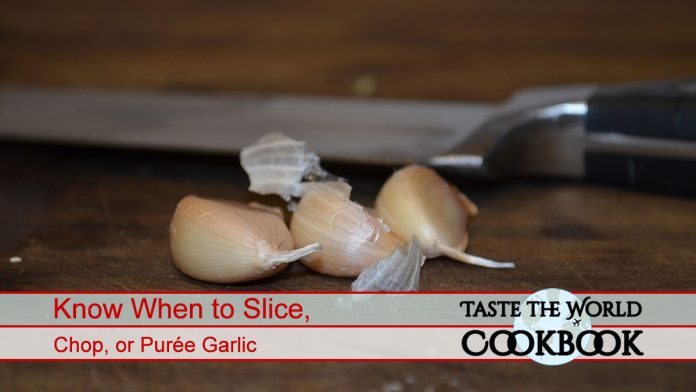Table of contents
In today’s culinary discussion, we’ll delve into the versatile world of garlic and how to determine when to slice, chop, or mince it. The way you prepare garlic plays a crucial role in producing allicin, the compound in garlic touted for its potential health benefits including cancer and heart disease prevention.
Cutting or crushing garlic activates the enzyme alliinase, which interacts with alliin to generate allicin. For maximum health benefits, you should finely chop or crush garlic cloves and let them rest for about 10 to 15 minutes before cooking to fully release the beneficial compounds.
Mastering Garlic: Know When to Slice, Chop, or Mince
Time needed: 2 minutes
Know When to Slice, Chop, or Mince Garlic
- Prepping the Garlic
Begin by peeling the garlic, trimming the hard nib at the bottom of the bulb. Roll the bulb on a non-stick mat, placed underneath your cutting board. This ensures the skin is removed without affecting the flesh.
- Knowing When to Slice
When to slice, chop, or mince the garlic depends on your recipe. If you aim for texture and a hint of nuttiness, slice the garlic about 1 millimeter thick. Sliced garlic brings a pleasant mouthfeel to dishes and adds visual intrigue.
- Deciding When to Chop
For quick or sautéed dishes, enhancing the robust garlic flavor involves finely chopping it. This should be added towards the end of high-heat cooking, providing a clean, spicy garlic punch to your dish.
- Understanding When to Mince
For slow-cooking dishes like soups and stews, minced or pureed garlic is ideal. Chop the garlic on a cutting board, sprinkle some coarse salt over it, and use the flat side of your knife to grind it into a puree directly on the board.
With this information at your fingertips, you can expertly slice, chop, and mince garlic according to your cooking needs.
Diversity of Garlic Varieties
Garlic, indigenous to Central Asia, was first cultivated in the Mediterranean region about 5,000 years ago. Known for its strength-enhancing properties, garlic was consumed by Gladiators before battles, and by Egyptian slaves while constructing the pyramids.
Belonging to the Allium or onion family, garlic is one of 700 species. The two primary types are Softneck (Allium sativum) and Hardneck (Allium ophioscorodon), also known as Stiffneck. Some also classify Elephant Garlic as a third type.
- Softneck Garlic further categorized into Artichoke and Silverskin, is typically found in supermarkets and is probably the one you’ve used most often.
- Hardneck Garlic features large cloves with intense flavors and easy peeling properties, although its shelf life is shorter, lasting about four to five months.
- Elephant Garlic a variant of the leek, and part of the onion family, often confuses people due to its garlic-like appearance and large bulbs. Containing only three or four cloves, it has a mild, sweet onion-garlic flavor.
Preserving the Potency: Essential Garlic Storage Tips
Garlic’s flavor is a gift to home cooks around the world, and preserving its potency requires a little know-how. To keep garlic at its flavorful best, it’s crucial to store it correctly. Here are some helpful tips for storing garlic that ensure it remains fresh and ready for your next culinary creation.
Whole Bulbs: The best way to store fresh, whole bulbs of garlic is in a cool, dark place with good air circulation. A pantry or cellar is often ideal. Avoid refrigeration, as it can cause garlic to sprout. Similarly, don’t store garlic in a place that’s too warm, as it can start to dry out. A mesh bag or a basket is a good storage container for whole garlic bulbs, as they allow for air circulation.
Separated Cloves: Unpeeled garlic cloves can last about a week at room temperature. Once you’ve broken the bulb, try to use the cloves quickly. However, if you have too many cloves left, keep them in a small, breathable bag in a cool, dark place.
Chopped or Minced Garlic: Chopped or minced garlic should be used as soon as possible. The exposure to air starts to diminish its flavor quickly. If you have to store it, refrigerate in an airtight container and use within a couple of days.
Preserving in Oil: Garlic infused oil is a popular way to store minced or chopped garlic. However, it’s important to use this method with caution due to the risk of botulism, especially if kept at room temperature. Always refrigerate garlic-infused oils and use them within a week.
By adhering to these garlic storage tips, you can retain the flavor punch that garlic provides to countless dishes. Enjoy your culinary journey with garlic, knowing it’s stored to maintain peak freshness and potency.
Delicious Dishes Featuring Garlic
Dive into the rich, bold world of garlic with our latest collection of recipes where this aromatic gem truly takes center stage. With its unique ability to enhance flavors and transform dishes from ordinary to extraordinary, garlic is indeed a culinary superstar. Whether it’s subtly enhancing the flavor profile of a dish or boldly commanding attention, the versatility of garlic is unrivaled. These recipes celebrate the diversity of this humble ingredient and invite you to experience its magic in your own kitchen. So, why wait? Let’s embark on this garlicky culinary journey together!
